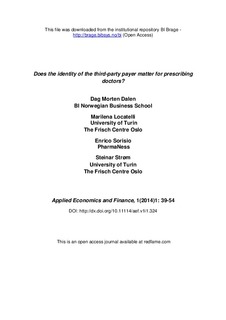Does the identity of the third-party payer matter for prescribing doctors?
| dc.contributor.author | Dalen, Dag Morten | |
| dc.contributor.author | Locatelli, Marilena | |
| dc.contributor.author | Sorisio, Enrico | |
| dc.contributor.author | Strøm, Steinar | |
| dc.date.accessioned | 2014-06-02T13:05:27Z | |
| dc.date.available | 2014-06-02T13:05:27Z | |
| dc.date.issued | 2014 | |
| dc.identifier.citation | Applied Economics and Finance, 1(2014)1: 39-54 | nb_NO |
| dc.identifier.issn | 2332-7294 | |
| dc.identifier.uri | http://hdl.handle.net/11250/195740 | |
| dc.description | This is an open access journal available at redfame.com | nb_NO |
| dc.description.abstract | TNF-alpha inhibitors represent one of the most important areas of biopharmaceuticals by sales, with threeblockbusters accounting for 8 per cent of total pharmaceutical sale in Norway. Novelty of the paper is to examine, with the use of a unique natural policy experiment in Norway, to what extent the price responsiveness of prescription choices is affected when the identity of the third-party payer changes. The three dominating drugs in this market, Enbrel, Remicade, and Humira, are substitutes, but have had different and varying funding schemes -hospitals and the national insurance plan. A stochastic structural model for the three drugs, covering demand and price setting, is estimated in a joint maximum likelihood approach. We find that doctors are more responsive when the costs are covered by the hospitals compared to when costs are covered by national insurance | nb_NO |
| dc.language.iso | eng | nb_NO |
| dc.publisher | RedFame Publishing | nb_NO |
| dc.subject | Pharmaceuticals | nb_NO |
| dc.subject | discrete choice model | nb_NO |
| dc.subject | funding-schemes | nb_NO |
| dc.title | Does the identity of the third-party payer matter for prescribing doctors? | nb_NO |
| dc.type | Journal article | nb_NO |
| dc.type | Peer reviewed | nb_NO |
| dc.source.pagenumber | 39-54 | nb_NO |
| dc.source.volume | 1 | nb_NO |
| dc.source.journal | Applied Economics and Finance | nb_NO |
| dc.source.issue | 1 | nb_NO |
| dc.identifier.doi | 10.11114/aef.v1i1.324 | |
| dc.description.localcode | OA | nb_NO |
Tilhørende fil(er)
Denne innførselen finnes i følgende samling(er)
-
Scientific articles [2147]
